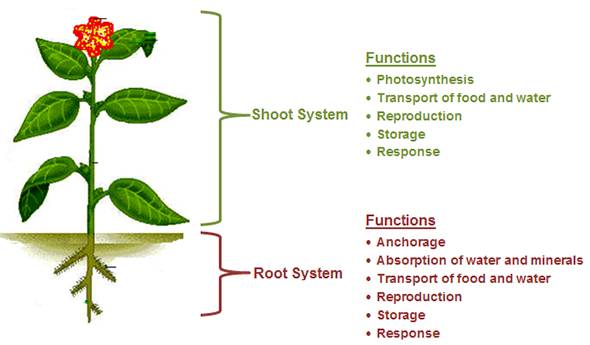A root is defined as the cylindrical organ of the plant which extends downward: away from the sunlight. Chlorophyll, bud, leaf, branch, etc., are not present in the root area. It consists of little root hairs present on the root cap (which lies at the tip of the root). These root hairs absorb water, nutrients, and minerals from the ground. Moreover, the roots provide support to the plant by anchoring it in the ground.
There are two types of roots:
- Taproot
- Adventitious root
1. Taproot
Taproot is the first straight and thick root that originates in the seed by the elongation of radicals. A taproot is a chief root from which other small roots grow laterally. The taproot has a tapering shape.
The taproot is further divided as:
- Fibrous tap root
- Tuberous tap root
- Fibrous tap root:
Taproot continues to elongate and give off little cylindrical branches, but these branches do not grow thicker. Such a long taproot system is known as a fibrous taproot system. There are small swellings of nodules so known as nodulated roots. The nodules possess particular bacteria which play an essential role in fixing the atmospheric nitrogen to form nitrates. The nitrogen-fixing bacteria nourish the plants with nitrate, in return, these bacteria reside in the roots of the plant.
- Tuberous tap root:
Taproots with thicker and swollen shapes contain stored food and are known as tuberous taproots, such as carrot, reddish, and turnip. Biennial (live for two seasons) plants produce leaf only and store this food in the taproot in the first season. In the following/next season, they utilize that reserved food for the production of flowering shoots, and after that, they die.
Fusiform root
Fusiform tap root has a spindle-like shape: bulged from the centre and quiet, taper from the end. English carrot is an example of this root type.
Napiform root
The middle portion is highly swollen of the napiform tap root, and it tapers towards the lower end. Turnip belongs to this root system.
Conical root
In a conical tap root system, the upper part is protruded, and it gradually tapers towards the lower side, such as reddish.
2. Adventitious root
Roots that emerge from the stem area and also can originate from the leaf area are known as adventitious roots.
They are further divided as
- Prop root
- Stilt root
- Aerating root
- Aquatic root
- Aerial root
- Prop root:
Prop root originates from horizontally aerial branches (widely spreading) and grows downward in the air to absorb the moisture. On touching the ground, they penetrate the soil and then start to absorb nutrients in the form of water and minerals. With the passage of time, these roots become inflexible and create pillars or props to reinforce the branches. That is why they are known as prop roots. A very familiar example is the roots of the rubber plant.
- Stilt root:
The type of root arises from the lower portion of the plant: from basal nodes of the plants near the soil area and grows randomly in the soil. These roots are known as stilt roots. They support the plants by fixing them into the soil firmly and keeping them upright. In Maze and Sugar Cane, the roots are stilt roots.
- Aerating roots:
Some vertical plants have an underground root projecting system, touching the surface of the soil. These roots are known as aerating roots, which are spongy in texture and have openings on their surface for the entrance of the air. They serve for the aeration of the plant.
- Aquatic root:
In many plants, clusters of fibrous adventitious roots emerge from the stem. These roots are usually without root hair. Aquatic roots are absorbed in water.
- Aerial roots:
The type of adventitious roots above the ground. They pass from some distance through the air before reaching the soil or remain hanging in the air.
Clinging root
In some plants like pepper, the stem grows numerous short adventitious roots which are known as clinging roots. These are sensitive to contact when they touch appropriate support. The clinging root normally secretes a sticky fluid which soon rises in the air, thus helping to fascinate the plant to the support.
Absorbing root
In tropical rainforests where the air is very moist. There are very small plants that depend upon the branches of the tree and have no connection with the soil. They send their long adventitious root which hangs freely in the air and absorbs water from it. These absorbing aerial roots are covered with the dead spongy tissue known as velamen. These serve to absorb and store water.
Parasitic root
In parasitic flowering plants like Cuscuta short thin adventitious roots arise from the stem of the parasitic points. These roots are known as parasitic roots. They stab the stem and branches of the host and become associated with its conducting tissue. Thus, they absorb water, prepare food from the host and pass it to the stem of the parasitic plant.


